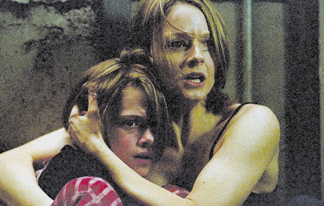Forced Asylum
New thriller
By Cole Smithey

"Who's there?" "Uh ma'am, Avon. Candygram. Landshark."
David Fincher's Panic Room opens with a sumptuous credit sequence so captivating that you're drawn into the movie before a single word is spoken. Fincher, like Hitchcock and Polanski, understands implicitly the
importance of every split second of film, and the credit sequences of his films are textbook examples. Giant white marquee lettering suspends at odd angles over various live-action Manhattan locations to the sound of a clock softly ticking. The opening has a postmodern-retro informed ambance that drips with majestic neogothic portent and subtly references movies like Rear Window and Wait Until Dark. The film that follows lives up to every bit of suspense and tension that those classic movies still induce today.
Fincher (Seven, The Game) is an audacious director interested in the pure physicality of emotion and movement to bear witness to hidden mysteries. No other living director goes as far in assessing the molecules of energy at the core of the stories he directs. Fincher's last film polarized audiences; Fight Club, much like Mary Heron's American Psycho, is a film you either adore or condemn for its deeply-rooted violence and dark social commentary.
With Panic Room, Fincher will likely have more luck converting audiences to his side because of the simplicity of its story and the extensive degree he goes to in expressing fear from the claustrophobic confines of a 'safe' place.
Panic Room (written by David Koepp, Stir of Echoes) is a terror/suspense movie that promptly takes you to the edge of your seat and pins you there with its tug-of-war between immaculate photography and tension-filled plot. As a battle of wits escalates between a mother with her teenage daughter and a trio of home intruders, we get to savor a simultaneously best and worst case scenario of a most precarious kind.
Meg Altman (Jodie Foster) is the recently divorced wife of a wealthy pharmaceutical giant (Patrick Bauchau, The Rapture) who moves, with her teenage daughter Sarah (Kristen Stewart), into a spacious upper west side 'townstone' previously owned by a paranoid millionaire. The home's master bedroom is equipped with a high-tech, steel-reinforced 'panic room' in the event of intrusion or outside attack. With its own phone line, ventilation system, toilet, supplies, and bank of home surveillance monitors, the room also contains, unbeknownst to Meg or Sarah, something intruders might want.
One of the men who constructed the home's 'safe room' Burnham (Forest Whitaker), has conspired with Junior (Jared Leto), a former caregiver of the previous owner, to break into the safe while the house is vacant.
But Junior has covered his bases and elicited the help of another, more experienced thief named Raoul (Dwight Yoakam) to assist in the robbery complete with ski-mask, rubber gloves, and a silenced automatic pistol.
Once the thieves realize that they are not alone, Meg and Sarah escape to the panic room (a plot point given away in the trailer), which becomes an urgent refuge sitting uncomfortably as the very target that the thieves will do anything to break into.
The movie percolates in jolts and sustained dread over a brilliantly ominous score by Howard Shore (The Lord of the Rings: The Fellowship of the Ring).
The film is shot almost entirely in the eerie interior dark of a house barely lit by outside moonglow. Shore's noninvasive music chides, confirms, and punctuates at turns the drama that unfolds as the thieves bicker and attempt various ploys to lure Meg out or to invade the room.
Apart from one plot twist too many near the end of the story, Panic Room is a perfect suspense-thriller with a top-notch cast.
Jodie Foster was past due for another foray into the suspense genre (after Silence of the Lambs) and brings a genuine maternal warmth (she was also pregnant during most of filming) to the role of a mother fighting with her every nerve and sinew to defend her family.